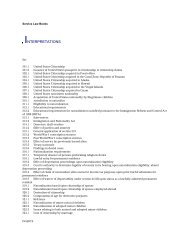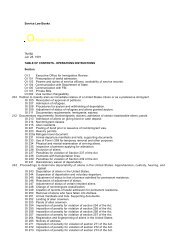Create successful ePaper yourself
Turn your PDF publications into a flip-book with our unique Google optimized e-Paper software.
<strong>Inspector's</strong> <strong>Field</strong> <strong>Manual</strong><br />
during the inspection. Forward these for data entry. Passenger lists on Form I-418 are no longer retained after<br />
inspection [See Chapter 22.7 for I-92/I-94 forwarding instructions.].<br />
23.5 Payoff and Discharge of Crewmembers.<br />
(a) General. Crewmembers who are leaving a vessel to return home or to join another vessel may be permitted<br />
to land as D-2, if required information is available at the time of inspection, or they may be granted a change to<br />
D-2 status later, after being permitted to land as D-1. In the latter instance, ordinarily the ship's agent will bring<br />
the alien and required documentation to the INS office for processing. Local policies may restrict hours and<br />
other conditions for processing D-2 requests. Application is made in accordance with the requirements stated in<br />
8 CFR 252.1 and the instructions on Form I-408. When reviewing the documentation, ensure that the alien has a<br />
confirmed transportation ticket to leave the U.S. or a written notification of acceptance by the master of the vessel<br />
which he or she will join. Upon approval, endorse a new I-95 and collect the previously issued D-1 Form I-95<br />
(do not collect Form I-184). Return the first and third copies of the I-408 to the master or agent, one to be filed<br />
with the vessel's departure manifest, the other to be retained by the master or agent. Route the second copy to the<br />
port of arrival. If there is reason to believe that a crewmember will not comply with the terms for departure<br />
indicated in the D-2 request, deny the request and revoke the conditional landing permit, following the<br />
procedures described in Chapter 23.10.<br />
(b) Exception for Certain Crewmembers Rejoining a Vessel. Ordinarily, a D-1 crewmember serving on a<br />
vessel is expected to depart with the same vessel from each U.S. port, unless he or she obtains D-2 status.<br />
However, with permission from the ship's master, a crewmember can depart the ship and rejoin it at another U.S.<br />
port, without obtaining D-2 status, if neither the vessel nor the crewmember will depart the U.S. and the<br />
crewmember will rejoin the vessel within his or her initial period of D-1 permission to land.<br />
23.6 Refusals.<br />
A decision to refuse a crewmember is not reviewable; your decision as the inspecting officer is, for all practical<br />
purposes, final. Occasionally, the master or other ship's officer may advise you of crewmembers whom they<br />
suspect are likely to abscond. Consider this information carefully when making your decision whether to permit<br />
landing or to detain the crewmember. Although local policy in some offices is to detain "first-trippers," new<br />
crewmembers on cargo vessels, as high risk applicants, this is not Service policy. A decision to detain should be<br />
based on clear, articulable facts. If you refuse a landing permit for any reason, endorse the I-95 with the<br />
"Refused" stamp and the code "P" for invalid passport, "V" for invalid visa, "M" for malafide crewmember, or the<br />
appropriate subsection of section 212 of the Act for other inadmissible aliens. Return a copy to the master or<br />
agent. Enter the alien's name on Form I-410 and void the alien's I-184, unless the refusal is solely based on<br />
passport or visa validity. Note the action taken on the I-418. Prepare and serve the master or agent with Form<br />
I-259, Notice to Detain, Remove, or Present Aliens. Retain one copy of the I-259 to be included with the other<br />
paperwork for the vessel. Follow local procedures for notifying Enforcement (Investigations or Border Patrol,<br />
as appropriate) of the action taken.<br />
23.7 Deserters and Abscondees.<br />
Control of deserting crewmembers is generally an Enforcement function, but Inspectors should be familiar with<br />
procedures, assist when needed, and take appropriate action during the inspection process to reduce potential<br />
desertion opportunities. An "abscondee" is a crewmember who has been refused a landing permit and who<br />
departs the vessel without permission. A "deserter" is a crewmember who has been granted D-1 or D-2 status<br />
and who leaves the vessel with no intention of returning. Often, the Inspector is advised during the initial<br />
inspection of the vessel of the possibility that a particular crewmember may "jump ship." It is generally<br />
advisable to detain potential deserters on board the vessel and discuss security arrangements with the master or<br />
agent. If you are advised, after the fact, of a desertion (which the master or agent is required to do pursuant to<br />
section 251(b) of the Act), immediately report the matter to the appropriate local Enforcement personnel, collect<br />
the deserter's travel document and prepare Form I-409 if local procedures dictate. If possible, obtain a sworn<br />
statement containing the facts surrounding the incident from the master, for use when instituting section 254 fine<br />
proceedings. See details regarding sworn statements in Chapter 43.<br />
23.8 Stowaways.




